Functional feed additive APEX® BRANCHIA may enhance fish productivity and survival, repelling ectoparasites and boosting the antimicrobial properties of the mucus
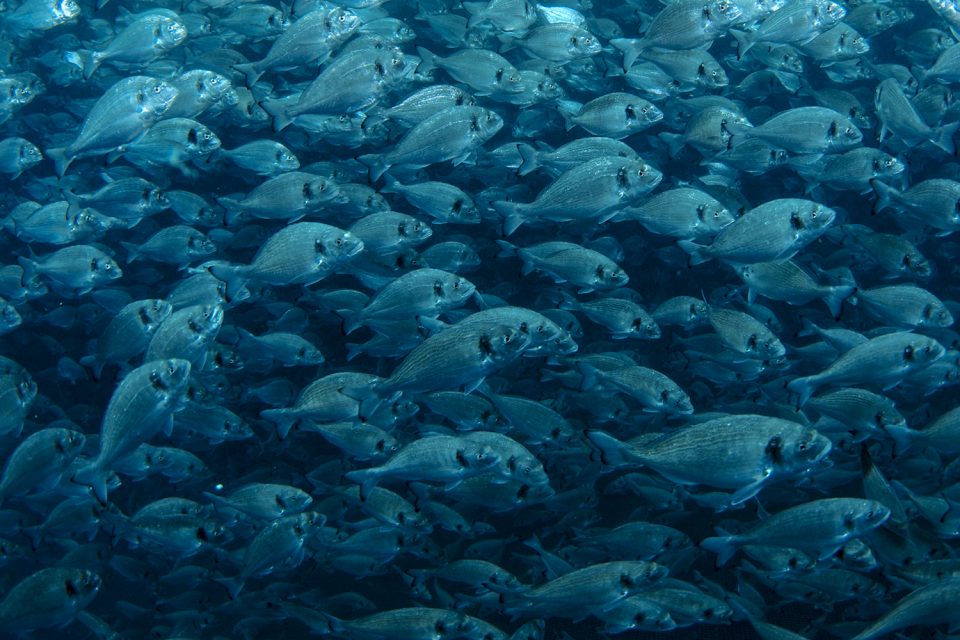
Aquaculture is one of the fastest growing food-producing sectors, currently accounting for 50 percent of the world’s fish used for sustenance according to the Food and Agriculture Organization (FAO) of the United Nations. But the sector’s expansion is largely inhibited by one barrier: fish diseases. For aquaculture businesses to thrive, fish farmers rely on high survival rates and rearing healthy fish.
Over the last few decades, the aquaculture industry has tapped into technology – vaccines, probiotics, diet modification, antibiotics – to improve disease management and enhance fish health and welfare. One such innovation is APEX® BRANCHIA – a functional feed additive to reduce the impact from monogenean gill parasites on the productivity and survival of fish. Developed by Adisseo, one of the world leaders in animal nutrition, it promotes the immune competence of fish and its efficacy to resist parasitic infestation. For the aquaculture industry, this technology could offer a tool to reduce fish disease outbreaks.
Disease outbreaks threaten the aquaculture industry
Disease outbreaks are among the major factors that hamper productivity while inducing substantial economic losses to the industry. Parasitism is a case in point because during this non-mutual symbiotic relationship, parasites take advantage and harm the host for their own survival and proliferation. Due to high stocking densities, susceptibility of the hosts and natural presence of the parasites in the environment, aquaculture provides favorable conditions for parasitic infections.
External parasites, else ectoparasites, are those that encounter and colonize the first defense barriers of the fish: skin, gill and mucus, causing significant health issues in both marine and freshwater species. In Mediterranean aquaculture Sparicotyle chrysophrii is the most notoriously known monogenean gill parasite of gilthead sea bream, Sparus aurata (Sitjà-Bobadilla, et al., 2010). Numerous studies have been conducted to explore its life cycle and suggest efficient ways to mitigate the infestations, whereas the development of parasite control strategies has been main focus of EU projects, such as ParaFishControl. Similarly, for the emerging aquaculture species great amberjack (Seriola dumerilli), the monogenean parasite species Zeuxapta seriolae has been a major issue and has concerned scientists and aquaculture experts. Other than the Mediterranean, the parasitic copepod sea louse (Lepeoptheirus salmonis), which is fed on the skin, blood and mucus of Atlantic salmon (Salmo salar), has been the scourge of the salmon industry and has led to large annual investments in research, aiming to a complete and reliable preventive solution.
The management and control of parasitic infections is of utmost importance for the sustainability of aquaculture industry but also for mitigating horizontal transfer of parasites to wild fish (Thorstad, et al., 2015). During a parasitic outbreak, the fish populations suffer from anemic gills which will not only lead to reduced performance and growth but also pave the way for secondary infections, such as opportunistic bacteria (Padros and Crespo, 1995), to come in and skyrocket mortality. Chemotherapy has generated some positive results and has been suggested as a candidate means of treatment (Rigos, et al., 2021). However, such strategies are not in line with the United Nations’ Sustainable Development Goals nor with widely shared fish welfare and environmental policies. Therefore, other more sustainable preventive methods must be developed.
The dietary inclusion of health-promoting additives has shown safe and potent results in mitigating losses, improving growth performance and enhancing FCR (Barrett, et al., 2020). The concept behind application lies in a dual function: support the first-line defense mechanisms (gills, mucus, skin) while repelling the ectoparasites from attaching to the host’s tissues. APEX® BRANCHIA is a health-supporting functional feed additive that is composed of a synergistic blend of natural ingredients aiming to reduce the severity of ectoparasite infections.
In this article, we report two individual studies based on the guppy (Poecilia reticulata) model, which corroborate the efficiency of APEX® BRANCHIA against ectoparasites while boosting the skin mucus innate immunity.
https://www.youtube.com/watch?v=P1N6SI4gK9c&feature=emb_logo
APEX® BRANCHIA significantly reduces the parasitic load in Gyrodactylus turnbulli infected guppies (Poecilia reticulata)
In vivo testing of functional feed additives is essential to both guarantee that the compounds are non-toxic for the host and prove their efficacy against the causative agent of interest. The Trinidadian guppy fish (Poecilia reticulata) model has already been validated for the assessment of antiparasitic compounds (Fridman, et al., 2014; Schelkle, et al., 2013) and the present study is a case in point. The utilization of the host-parasite system Poecilia reticulata and the monogenean Gyrodactylus turnbulli in a controlled environment secures replicability and consistency of the trial while reducing potential variability of the results. It is important to mention that Gyrodactylus sp. are typically found and reproduce on the skin and occasionally on the gills of the host (Lyles, 1990), therefore a good model parasite for some stages or species of monogeneans of commercial relevance such as young stages of Sparicotyle chrysophrii. Hence, the model has been applied in order to evaluate APEX® BRANCHIA as a preventive strategy against monogenean ectoparasites (Arapi, 2019).
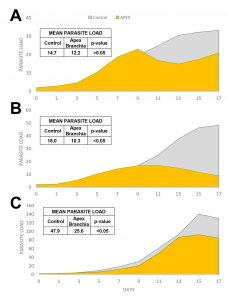
The experimental design included three individual trials in 1-liter aquaria: one with juvenile (mean standard length ± SE: 8.8 ± 0.6 mm) and two with adult guppy individuals (mean standard length ± SE: 28.9 ± 0.2). In each trial, there were two groups of animals (n=18 per group) fed with two guppy flake diets: control (no additive) and treatment (0.5% APEX® BRANCHIA), over a 14-day period.
On day 15, two G. turnbulli individuals were placed on the caudal fin of each guppy, while anesthetized. All fish were inspected the following day to confirm that the infection was successful. The same feeding pattern was followed for 17 more days in both groups till day 31, when the experiment was completed. The parasitic infestation was monitored every 48 hours upon anesthetizing the fish and statistical analysis was conducted using a generalized linear mixed effect model.
It was shown that the APEX® BRANCHIA supplemented diet could efficiently control the parasitic infestation by generating consistently decreased parasitic load across all individual trials (Fig. 1). In the first juvenile trial (Fig. 1A), the treatment-fed group had 17 percent fewer parasites, yet the result was not statistically significant.
However, in the second and third adult guppy trials (Fig. 1B, C), the parasitic load dropped by 43 percent and 47 percent, respectively. The parasitic infestation in the second trial was less intense than in the third, hence the decline in the numbers was observed already at day 9 compared to day 13 post-infection, respectively. The decrease of the number of parasites for the treatment-fed groups was statistically significant in both adult trials, documenting the antiparasitic efficacy of APEX® BRANCHIA at both high and low-intensity infestations.
APEX® BRANCHIA boosts skin mucus antimicrobial properties increasing protection against secondary infections
Skin mucus is a core element of the fish innate immunity system and constitutes the first physicochemical line of defense against pathogens (Subramanian, et al., 2007). The function of mucus has been related to antimicrobial properties which contribute to protection against secondary infections and opportunistic bacteria (Dash, et al., 2018; Tiralongo, et al., 2020). APEX® BRANCHIA was used in order to evaluate the bactericidal effect of the mucus of gilthead sea bream, Sparus aurata against Escherichia coli and Pseudomonas anguilliseptica.
Three groups of gilthead sea bream (~180 grams) were fed for four weeks with an APEX® BRANCHIA supplemented feed (0.6 percent inclusion rate) based on a commercial-like formula. Three more groups served as control and were fed with the same feed without the additive. Upon completion of the experiment, samples of the mucus from both control and treatment groups were taken according to a non-invasive standard protocol (Fernández-Alacid, et al., 2018).
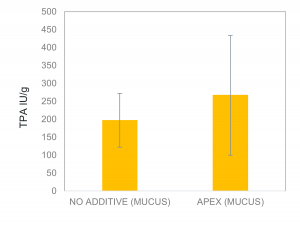
The total alkaline protease activity (TPA), a reliable metric to evaluate the ability of the mucus to degrade the peptide bond of the peptidoglycan in bacterial cell walls, along with the inhibitory effect of the mucus, were both assessed against two bacterial strains: a non-pathogenic E. coli (DSMZ collection number 423) and a pathogenic P. anguilliseptica (CECT collection number 899T), following a previously published protocol (Sanahuja, et al., 2019). Statistical analysis was conducted using an independent t-test.
The supplementation with APEX® BRANCHIA increased the biological activity (IU/g) of TPA by 30 percent (Fig. 2), which can be translated into an increased proteolytic potential of the mucus. However, due to the high variability among the measurements, no statistical significance was observed. Therefore, a higher number of replicates would improve the statistics and lead to a more concise result. As far as the inhibitory effect is concerned, APEX® BRANCHIA consistently delayed the growth of both bacterial populations during both exponential and early stationary phases (Fig. 3), corroborating to the previous TPA result. Therefore, the preventive antibacterial properties of the mucus are optimized by the dietary inclusion of APEX® BRANCHIA.
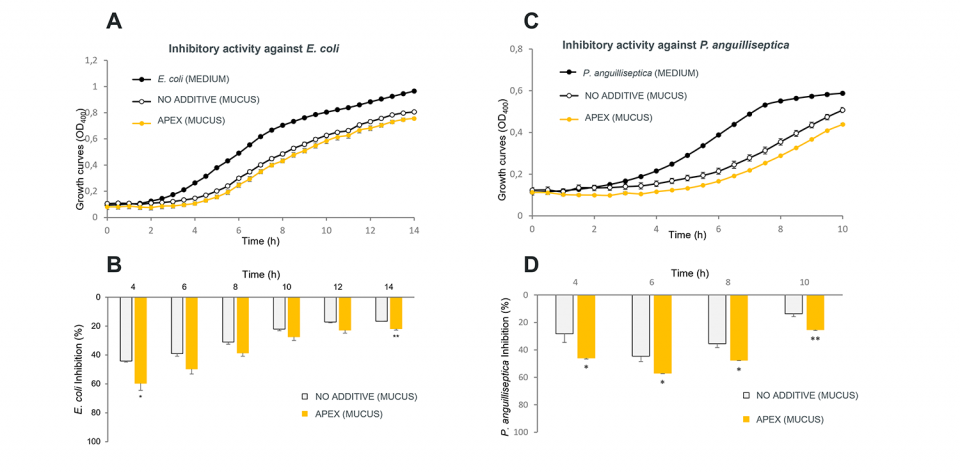
Conclusion
The prevention and control of external parasites are crucial for a successful, healthy and profitable production in aquaculture not only because of their direct negative impact such as anemia, but also due to their indirect assistance to secondary opportunistic infections. Functional feed additives can be used in the diets and make a difference under the concept of a sustainable, preventive strategy. The synergistic blend of natural components in APEX® BRANCHIA was able to a) reduce the ectoparasites from the fish and b) improve the antibacterial properties of the mucus, decreasing the risk for secondary infections.
The present study proves that feed supplementation with APEX® BRANCHIA can make a positive impact against ectoparasites. The Health Platform at Adisseo focuses on optimizing disease prevention programs and supports customers in the use of in-feed additives and complementary farm care solutions.
References available upon request.
Author
-

Adisseo
This article was prepared by Panos G. Kalatzis, Maria Mercè Isern-Subich and Waldo G. Nuez-Ortín.
Tagged With
Related Posts
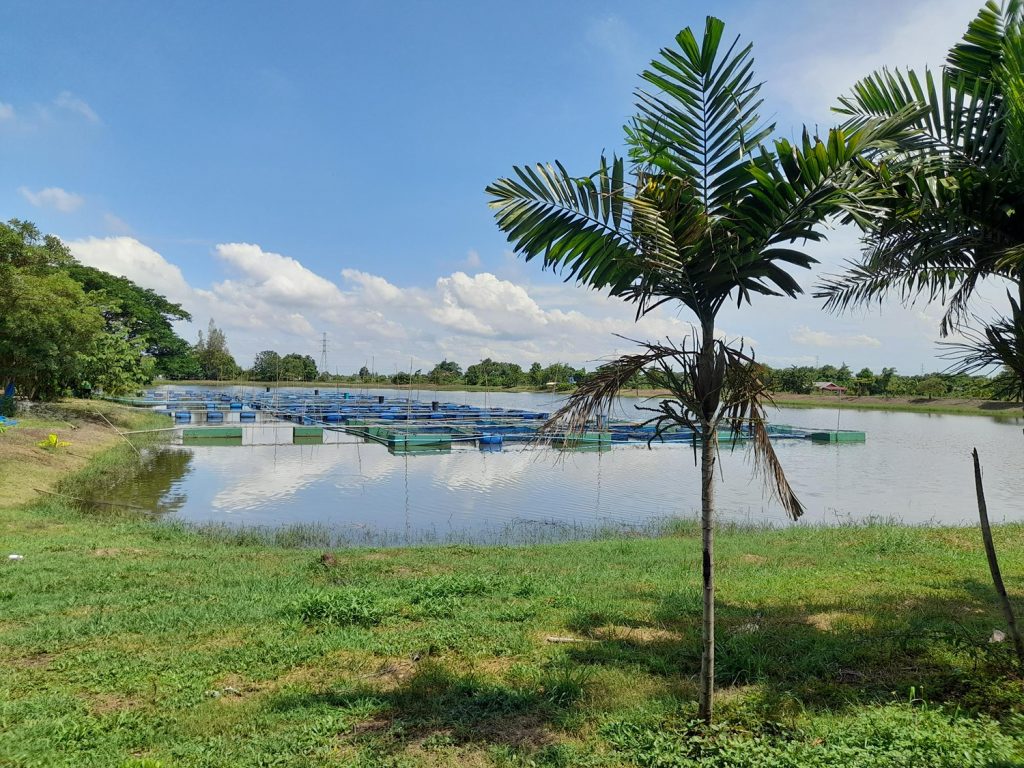
From Our Sponsors
Aquafeed additive from Adisseo can reduce the impact of bacterial diseases for fish and shrimp
In aquaculture trials with Pacific white shrimp and Nile tilapia, Bacti-nil® Aqua, an aquafeed additive from Adisseo, effectively prevented disease and promoted growth.

